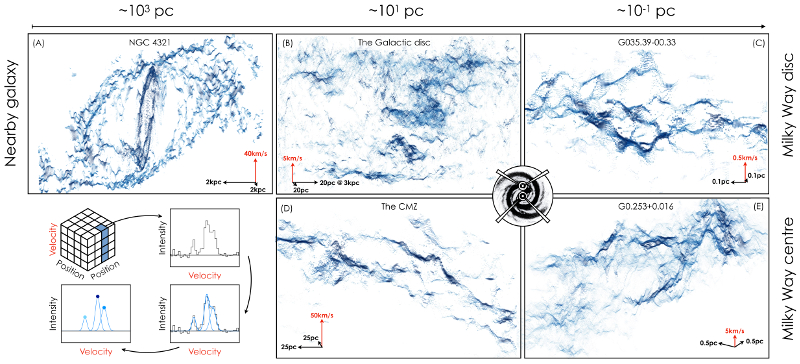| EPoS Contribution |
|
Ubiquitous velocity fluctuations throughout the molecular interstellar medium
Jonathan Henshaw MPIA, Heidelberg, DE | |
| The density structure of the interstellar medium (ISM) determines where stars form and inject energy, momentum, and heavy elements into their host galaxy. The pockets of dense gas out of which stars form are both seeded and amplified by gas motion, but the exact nature of these gas flows is unknown across spatial scale and galactic environment. Determining what sets the scale and magnitude of these flows, as a function of environment, is key to understanding how the energy and momentum injected by stars drives galaxy evolution. Although dense star-forming gas likely emerges from a combination of instabilities, convergent flows, and turbulence, establishing the precise origin is challenging because it requires quantifying gas motion over many orders of magnitude in spatial scale. In this contribution, I will demonstrate how we have measured the motion of molecular gas in both the Milky Way and nearby galaxy NGC 4321, thereby assembling observations that span an unprecedented spatial dynamic range (10-1-103 pc). I will present the detection of ubiquitous velocity fluctuations discovered across all spatial scales and galactic environments. Statistical analysis of these velocity fluctuations uncovers how star-forming molecular gas is assembled. I will discuss the discovery of oscillatory gas flows with wavelengths ranging from several hundred parsecs down to a few tenths of a parsec. These flows are coupled to regularly-spaced density enhancements which likely form as a result of gravitational instabilities. I will also discuss the identification of stochastic and scale-free fluctuations in velocity and density, consistent with the structure generated in turbulent flows. I will discuss these findings in the context of the multi-scale dynamical assembly of dense star-forming gas in the ISM. | |
 | |
| Caption: Position-position-velocity (PPV) volumes of different galactic environments. The data points indicate the X-Y position and velocity of individual Gaussian emission features. The colour indicates the peak intensity of each emission feature (see the cartoon in the bottom-left). The different columns illustrate decreasing spatial scale, from kpc scales down to sub-pc scales. The rows highlight differences in galactic environment, from galaxy discs (top) to the Central Molecular Zone (CMZ; bottom). The individual regions in each panel are as follows: NGC4321 (A); a region in the Milky Way's Galactic disc (B); the Northern part of the infrared dark cloud (IRDC), G035.39--00.33 (C); the inner 250pc of the Milky Way, the CMZ (D); and the IRDC G0.253+0.016 (E). We include 3-D scale bars in the bottom corners of each panel to indicate the physical scaling as well as the orientation of each PPV volume. | |
| Collaborators: D. Kruijssen, U. Heidelberg, DE S. Longmore, LJMU, UK M. Riener, MPIA, DE ++ PHANGS and others |
Suggested Session:
Molecular Clouds |

